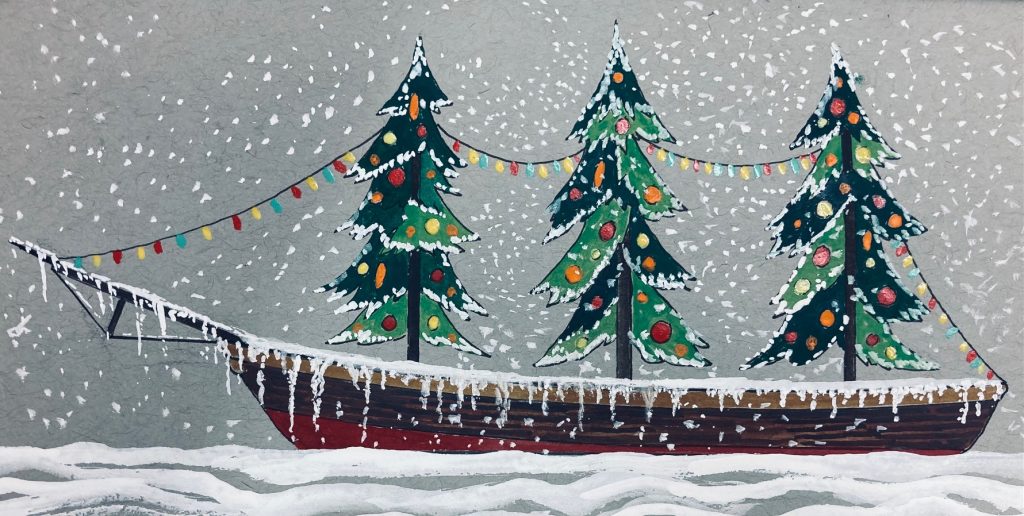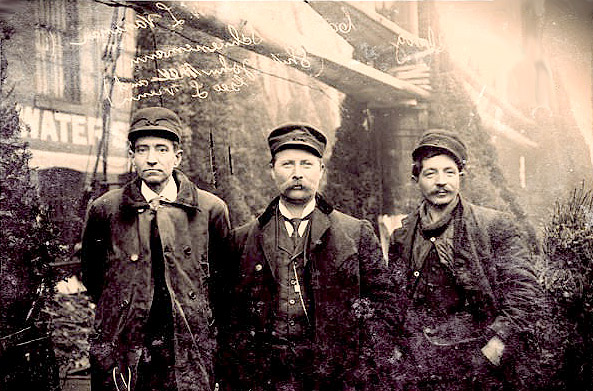If you lived in Chicago at the turn of the century from 1876 to 1911 during the Christmas holiday season and you were a little girl with braids and ear muffs or a boy with knickers, coat, and pork pie hat, you would be anxiously awaiting the traditional “Christmas Tree Sloop”! This vessel’s proper name was the Rouse Simmons. She was built and launched in Milwaukee, Wisconsin, on August 15, 1868, by Allen McClelland for the Great Lakes trade. She was 123.5’ in length and had a beam of 26.6’ and was usually crewed by the captain and four mates.

The Great Lakes were and still are crucial to America’s and Canada’s maritime trade. Many sloops like the Rouse Simmons would sail from port to port in all the Great Lakes delivering lumber, grains and other foods, iron ingots and even passengers. Lakes Superior, Huron, Michigan, Erie and Ontario comprise the largest freshwater system on earth, supplying 20% of all fresh water on our planet. Some scientists think of these lakes as seas. They have currents, mighty waves, and even some tidal action. Lake Superior is the largest followed by Michigan, the lake that the Rouse Simmons sailed on
The custom of shipping Christmas trees to Chicago by sloop was pioneered by August Scheunemann in 1876. He used his vessel all season and would always move it south to Chicago before the lake froze. He came up with the idea of making his last run with his hull and deck filled with Christmas trees and selling them off the deck of his sloop, the S.Thal when it was dockside in Chicago. He could make a killing to support his family until shipping started again when the ice melted in the spring. He became fondly known as “Christmas Tree Scheunemann’’. Unfortunately, August and his vessel sank during a storm on November 9, 1898. All hands were lost. His brother Hermann continued in the lake trade and 1910 bought the Rouse Simmons and had her refitted to his needs.
The Rouse Simmons by then had already seen better days and had already one sinking incidence which was raised prior to Hermann’s purchase. Hermann worked the boat hard and she was not caulked properly and her deck was compromised by the coatings of salt Hermann put on it to manage any rot. Salt interacts badly with the deck nails so you can imagine what was slowly happening. But Hermann was a chance taker and decided to pick up over 5,500 Christmas trees at Thompson’s Harbor in Manistique, Michigan, and make a 300-mile run to Chicago. It was already getting iffy weather-wise but he left Port at 2 pm on November 22, 1912.
Hermann had already made a name for himself by the Clark Street Bridge dock. He outdid his brother when it came to marketing. His vessel was known for its bright Christmas lights all the way up the masts and the large sign that said “CHRISTMAS TREE SHIP! MY PRICES ARE THE LOWEST!! Hermann was soon known as ‘Captain Santa’’ and he played the part well. His trees sold from 50 cents to one dollar but he always gave loads of trees away to the needy in the Chicago slums. He outdid all competitors with his personality of laughter and compassion. As Hermann took the wheel of the Rouse Simmons he was optimistic even though he had been warned at the dock that rats were seen leaving his ship (A suspicious harbinger of danger for sailors). He already had mentioned they would probably run into some foul weather. Two of his crew of six refused to sail, so off he went with four plus himself. It was to be a five-day journey.

There had already been one large storm on the lake that November. When the ship sailed at noon, ships in the harbor were already hunkering down for a big blow. The vessel was overloaded and the storm came up fast. Captain Hermann sent two men onto the lower deck to check the lashings on the trees. A giant wave came up and over the deck and washed the two men overboard and forever to rest in the depths of the cold lake. Many trees then went over and it made the boat more maneuverable. Hermann knew he was in trouble so he tried to make for the safety of Baileys Harbor but the remaining trees on deck, the sails, lines and even he and his remaining men were becoming covered with ice
The next day Rouse Simmons was spotted at 2:50 pm from the Kewaunee Life Saving Station. She was sitting very low in the water, flag at half-mast to signal distress and her sails had been torn to shreds by the howling winds. The power lifeboat Tuscarora was sent out but try as they might, they could not reach the Rouse Simmons. She disappeared with the last two hands and “Captain Santa”.
In 1924, a fisherman was walking a beach on the lake and found a bottle, corked with a carved piece of pine wood and inside was a dry note that read; “Everybody goodbye. Leaking badly. God help us. Hermann Scheunemann””. The dock where he sold his trees was empty that year. The children didn’t come to see Captain Santa and his gaily lit Christmas Tree Ship. Many years later his wallet was found on a shore wrapped tightly in oilskin and all Hermann’s papers dry inside.
After the grief had somewhat subsided his wife and daughters continued Captain Santa’s tradition by importing trees by rail and renting a sloop for the Christmas season and continued selling trees for low prices and giving them away to the poorest from the slums. That is what Christmas is about, isn’t it?
